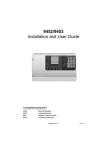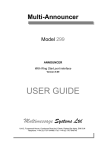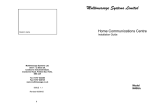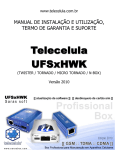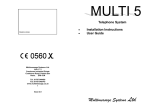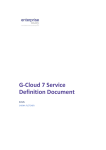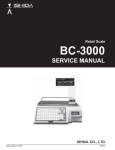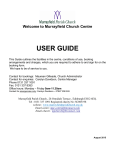Download USER GUIDE - Multimessage Systems Ltd
Transcript
Multi-Announcer Models 311 and 310 Automatic Announcement Switching With TMOM Interface Version 10.21 USER GUIDE Multimessage Systems Ltd Unit 2, Furzewood House,Cranborne Road Ind. Estate, Potters Bar Herts, EN6 3JN Telephone: AAS + TMOM version 10.21 ++44 (0) 1707 644480 Fax: ++44 (0) 1707 646745 1 Contents Introduction to your Multi-Announcer Facilities 3 Installation Choosing a suitable site Unpacking the system 4 Connections on front and rear panels and cable connections 5 Safety information Fitting a plug 10 Installation procedure 11 Read this first 12 Setting the time and date Reset system: Tests all ports and announcements Port type 13 Record Announcements The external input socket 15 Erasing Announcements Playing Announcements Daylight Saving 16 Week Plan set-up/review 17 Date Breaks set-up/review 18 Copy Week Plan/Date Breaks Free recording time available Version and revision of software 19 Total count of calls received Count of calls received for each port 20 Enable number of plays for each caller Key code for remote control 21 Security level for remote control Remote control of the Multi-Announcer 22 Automatic announcement selection Example 23 Program Bank Holidays 24 AAS + TMOM version 10.21 2 Introduction to your Multi-Announcer Read this section to get an overview of how your Multimessage Multi-Announcer works. This section also contains some important information about conditions for installing and connecting the unit There are two models in the Multimessage Multi-Announcer range: ♦ the Model 311, which is fitted in a one-unit-high case and may be equipped to answer 2, 4 or 6 lines ♦ the Model 310, which is fitted in a three/five-unit-high case and may be equipped to answer up to 15/31 lines The instructions in this User Guide apply to both models, except for the installation instructions which apply to the Model 311 only; the Model 310 must be installed by qualified engineers. Your Multimessage Multi-Announcer gives you the ability to play up to 60 pre-recorded announcements to your callers. Each caller hears the relevant announcement from the beginning. Each announcement can be assigned to just one port or to a group of ports, as you prefer. The automatic announcement switching facility, lets you set the system up so that callers hear different announcements at different times on different days. Some or all ports may have the same set of announcements; or each port may have a different one. For emergency situations this may be overridden so that all ports have an emergency announcement. This may be recorded and turned on/off remotely. The remote control access is via a 4 digit key code enabling recording and playing of any announcement in addition to the emergency control. To record announcements and set up the system, you use an ordinary tone-dialling telephone; and you can modify the announcements and settings while the system continues to answer calls. You can also use recordings made on an external device such as a cassette recorder or a CD player. Facilities This apparatus has the following facilities: ♦ ♦ ♦ ♦ ♦ ♦ ♦ ♦ ♦ ♦ ♦ ♦ ♦ ♦ ♦ ♦ ♦ ♦ ♦ ♦ ♦ ♦ ♦ ♦ Auto-answering. Auto-clearing. All callers hear the announcement from the beginning. Announcements can be modified while the machine continues to answer calls. Announcements may be recorded and played remotely via the last equipped port. Up to 60 announcements. Time, day of the week and date controlled selection of announcements. Any announcement may be assigned to any port. Emergency mode override announcement with remote activation and recording. Automatic daylight saving clock adjustment. The ability to take ports out of service at any time. Call counters for each port and for system total. Controlled from simple telephone with tone dialling. Key code protection for remote access. Any port can be enabled.disabled or forced to drop the call in progress. Ports can be assigned to groups of lines. Mains powered from 240 V AC, 100 mA,24W peak. Battery backup - running for three hours; 45 hours memory retention. Solid-state storage of announcements. 3.5 to 14 minutes on Model 311. 3.5 to 224 minutes on Model 310. 2,4 or 6 ports on Model 311. 2 to 31 ports on Model 310. Connection of external tape recorder or CD player for audio input and output ( -10dBm peak maximum input ). AAS + TMOM version 10.21 3 Installation These installation instructions apply to Multi-Announcer Model 311 only. Model 310 must be installed by engineers authorised by Multimessage Systems Ltd. If you are installing a Model 311 Multi-Announcer please make sure you follow the instructions carefully and in the order given. Choosing a suitable site The unit should be installed on a level, solid surface, where: ♦ The mains lead will reach a 240 V AC switched mains socket, preferably with a guard fitted so that it cannot be accidentally switched off. ♦ The telephone line cords will reach your telephone line sockets. ♦ There is a minimum of background noise, so that you can record your announcements satisfactorily. ♦ You can easily see the display (preferably at head height). ♦ The unit is away from direct sunlight or heating appliances ♦ Air can circulate around the unit (allow at least 10 mm clearance all round) ♦ The temperature is maintained between -10°C and 40°C. ♦ The unit is away from water or corrosive chemicals, particularly salt spray. Unpacking the System When you unpack the system from its box, you will find: ♦ The Model 311/310 Multi-Announcer. ♦ A mains lead with fitted plug (if you need to change the plug, refer to the 'Safety Information' page. ♦ The battery fuse. ♦ Telephone line cords (the quantity depends on the number of lines you purchased)/cable with krone termination strips. ♦ A telephone handset. ♦ This User Guide. AAS + TMOM version 10.21 4 Connections on front and rear panels - M311 The M311 may alternatively be supplied with hard wire connections see M310 connection strip assignment. RJ11 Pin No. 1 3 4 6 control 'c' wire audio 'a' wire audio 'b' wire control 'd' wire Connect 6 way cable 631A to RJ11 Port 1 Do not use Battery fuse holder Mains fuse 250 V 50-60 hZ 2 3 4 TEL No. (+44) 01707 644480 FAX No. MODEL No: 311 5 6 7 8 BATTERY FUSE 5 AMP MULTIMESSAGE SYSTEMS LTD TELEPHONE LINES MAINS FUSE 250 mA (T) (+44) 01707 646745 SERIAL No: 3281 DESIGNED AND MANUFACTURED IN THE U.K THIS FUSE MUST BE REMOVED WHEN NOT IN SERVICE Mains input socket Display Port indicators (on when port is TMOM type) (For analog type only on when port is busy). Socket for connecting telephone EXTERNAL AUDIO INPUT ACTIVE LINES 2 3 1 LOCAL Port 1 local handset indicator (on when port is busy) 4 5 6 Socket for connecting audio input from tape recorder or CD player 7 MAINS Mains power indicator light LOCAL HANDSET EXTERNAL AUDIO OUTPUT MULTIMESSAGE Systems Ltd M311 Socket for connecting audio input to tape recorder M311 with telephone connected to local control port 1 AAS + TMOM version 10.21 5 Connections on front and rear panels - M310 Software configuration label Mains fuse BATTERY FUSE 5 AMP MAINS FUSE 250 mA (T) TELEPHONE LINE SYSTEM CONFIGURATION THIS FUSE MUST BE REMOVED WHEN NOT IN SERVICE WARNING-THIS APPARATUS MUST BE EARTHED CAUTION: MAINS VOLTAGE Disconnect mains supply before removing covers ~240 V 50. . 60 Hz 30 W MULTIMESSAGE SYSTEMS LTD TEL No. (+44) 01707 644480 FAX No. MODEL No: 310 (+44) 01707 646745 SERIAL No: 3281 DESIGNED AND MANUFACTURED IN THE U.K Mains input socket Port 1 local handset indicator (on when port is busy) Battery fuse holder Telephone line Port indicators (on when port is TMOM type). (For analog type only on when port is busy). Socket for connecting telephone Socket for connecting audio input from tape recorder or CD player Display MULTIMESSAGE SYSTEMS MULTILINE ANNOUNCER M310 1 9 2 10 3 11 4 12 5 13 6 14 7 15 8 16 EXTERNAL AUDIO LOCAL HANDSET ACTIVE LINES LOCAL INPUT EXTERNAL AUDIO OUTPUT MAINS ON Mains power indicator light Socket for connecting audio input to tape recorder The Model 310 Multi-Announcer AAS + TMOM version 10.21 6 Cable Connections M310 Connection Strip Assignment Note-Port 1 is only used for the local control telephones. Connection Pair No 1 2 3 4 5 6 7 Strip 1 M310 Port 2 a,b 3 a,b 4 a,b 5a,b 6 a,b 7a,b 8 a,b Connection Pair No 1 2 3 4 5 6 7 Strip 2 M310 Port 2 c,d 3 c,d 4 c,d 5 c,d 6 c,d 7 c,d 8 c,d Connection Pair No 1 2 3 4 5 6 7 8 9 10 Strip 3 M310 Port NU NU NU NU NU Connection Pair No 6 7 8 9 10 Strip 4 M310 Port NU NU NU NU NU 12 a,b 13 a,b 14 a,b 15 a,b 16 a,b 1 2 3 4 5 12 c,d 13 c,d 14 c,d 15 c,d 16 c,d 8 9 10 9 a,b 10 a,b 11 a,b 8 9 10 9 c,d 10 c,d 11 c,d NU-Not Used. AAS + TMOM version 10.21 7 Connections on front and rear panels - M310L Port 1 local handset indicator (on when port is busy) Port indicators (on when port is TMOM type). (For analog type only on when port is busy) Socket for connecting telephone Socket for connecting audio input from tape recorder or CD player Display ACTIVE LINES LOCAL MULTIMESSAGE SYSTEMS 1 9 17 25 2 10 18 26 3 11 19 27 4 12 20 28 5 13 21 29 6 14 22 30 7 15 23 31 8 16 24 32 LOCAL HANDSET EXTERNAL AUDIO INPUT EXTERNAL AUDIO OUTPUT MULTILINE ANNOUNCER M310 MAINS ON Mains power indicator light Mains fuse Socket for connecting audio input to tape recorder Software configuration label BATTERY FUSE 5 AMP MAINS FUSE 250 mA (T) SYSTEM CONFIGURATION THIS FUSE MUST BE REMOVED WHEN NOT IN SERVICE TELEPHONE LINE MULTIMESSAGE SYSTEMS LTD TEL No. (+44) 01707 644480 FAX No. (+44) 01707 646745 WARNING-THIS APPARATUS MUST BE EARTHED CAUTION: MAINS VOLTAGE Disconnect mains supply before removing covers ~240 V 50. . 60 Hz 30 W Mains input socket AAS + TMOM version 10.21 MODEL No: 310 SERIAL No: 3281 DESIGNED AND MANUFACTURED IN THE U.K Battery fuse holder Telephone line 8 Cable Connections M310L Connection Strip Assignment Note-Port 1 is only used for the local control telephones. Connection Strip No 1 2 3 4 5 6 7 8 9 10 Strip 1 M310 Port 2 a,b 3 a,b 4 a,b 5 a,b 6 a,b 7a,b 8 a,b Connection Strip No 1 2 3 4 5 6 7 Strip 2 M310 Port 2 c,d 3 c,d 4 c,d 5 c,d 6 c,d 7 c,d 8 c,d Connection Strip No 1 2 3 4 5 6 7 Strip 3 M310 Port Connection Strip No Strip 4 M310 Port Connection Strip No Strip 5 M310 Port Connection Strip No Strip 6 M310 Port Connection Strip No 1 2 3 4 5 6 7 8 9 10 Strip 7 M310 Port 32 a,b NU NU NU NU NU NU NU NU NU Connection Strip No 1 2 3 4 5 6 7 8 9 10 Strip 8 M310 Port 32 c,d NU NU NU NU NU NU NU NU NU 9 a,b 10 a,b 11 a,b 8 9 10 9 c,d 10 c,d 11 c,d 8 9 10 12 a,b 13 a,b 14 a,b 15 a,b 16 a,b 17a,b 18 a,b 19 a,b 20 a,b 21 a,b 1 2 3 4 5 6 7 8 9 10 12 c,d 13 c,d 14 c,d 15 c,d 16 c,d 17 c,d 18 c,d 19 c,d 20 c,d 21 c,d 1 2 3 4 5 6 7 8 9 10 22 a,b 23 a,b 24 a,b 25 a,b 26 a,b 27a,b 28 a,b 29 a,b 30 a,b 31 a,b 1 2 3 4 5 6 7 8 9 10 22 c,d 23 c,d 24 c,d 25 c,d 26 c,d 27 c,d 28 c,d 29 c,d 30 c,d 31 c,d NU-Not Used. AAS + TMOM version 10.21 9 Safety information Please be aware of this important safety information before you install or operate your MultiAnnouncer. Only a simple telephone with tone dialling-such as the one supplied with the unit is to be connected to the LOCAL HANDSET port (see page 9). If you connect any other type of telephone, you may damage the unit and make it unsafe. Your Multi-Announcer is supplied with a mains lead terminating in a moulded plug suitable for connection to a typical 240 V AC mains socket (standard in the UK). Normally, you should not attempt to remove this plug: however, if you need to fit a plug for operation outside the UK, please make sure you follow these instructions; ♦ ♦ ♦ Connect the wire which is coloured BLUE to the terminal marked with the letter N or coloured BLACK. Connect the wire which is coloured BROWN to the terminal marked with the letter L or coloured RED. Connect the wire which is coloured GREEN AND YELLOW to the terminal marked with the letter E or an EARTH SYMBOL, or coloured GREEN or GREEN AND YELLOW. Fitting a plug Green/Yellow Blue wire Fuse Brown wire Cable clamp AAS + TMOM version 10.21 10 Installation procedure Please make sure you follow these steps in the correct order, and that you have read the safety information : 1 2 3 4 5 6 7 Carefully remove the unit from its plastic bag. Plug the local handset in to the front socket marked ‘LOCAL HANDSET’. Remove the battery fuse and holder from its bag. Fit it into the socket marked ‘BATTERY FUSE’ at the rear of the unit making sure it is securely screwed in. For the M311 plug the telephone line cords into the sockets marked ‘TELEPHONE LINES’ on the rear of the unit starting with the socket marked ‘2’. The socket marked ‘1’ cannot be used because the corresponding port is used for the local handset or for M310 hardwire lines on to the krone strips. Plug the mains lead into the socket at the rear of the unit. With the switch on the mains socket set to Off, plug the mains lead into the socket. Switch on at the socket. Watch the display and check that it shows the correct information as follows: When the Multi-Announcer is first switched on this is the information that appears on the screen. The display shows the date of issue and the software variant. This display indicates that the memory check is in progress, this should take approximately 30 seconds (large memory may take longer). The unit checks the size of installed memory and displays the memory size. 1 December 97 TMOM Version 10.20 Memory Check Please Wait... Memory top 81FF Size 0200 The number displayed shows the amount of memory on your system. The default display shows the current time/date and also shows the total number of calls answered by the system. Playing the current announcement for port 1 when the handset is lifted. 16:15 Wed 15 Mar 95 0 calls 16:15 Wed 15 Mar 95 Ann 1 You are now ready to set the system up to answer your callers. Go to Read This First. AAS + TMOM version 10.21 11 Read this first When you are setting up the system, there are a few basic principles to be aware of. When the unit is initially turned on, there are no announcements recorded. When the handset is lifted there will be a continuous bleeping noise, announcement 1 not recorded will be displayed. The bleeping noise will stop once you have recorded announcement 1. This bleeping noise is to enable the user to gain remote access even when there are no announcements recorded (this may be due to a power failure) e.g when remote access is attempted, a bleeping noise will be returned to indicate that the announcer is connected, instead of getting silence. Menus The system works via a series of menus-the display offers you a number of options, to be selected by pressing a key on the telephone. When you press a key, you may see another menu, inviting you to choose a further option. When you first switch the system on, the display shows the size of installed memory then after a few seconds the initial menu. Thereafter, by default the display shows the time, date and the number of calls received. If you then lift the handset and press the # key, you A ‘pip pip’ tone is played indicating that you are now in the initial menu What this means is that you can press: ♦ ♦ ♦ ♦ ♦ ♦ 1 to record or delete an announcement 9-Emergency 0-Normal 2 to play an announcement 1-Rec/Del 2-Play 9 to set to emergency mode, answer callers with emergency announcement 9 0 to stop emergency mode and return to announcements controlled by time and date # to see the 2nd menu * to return to play and display the current announcement for port 1 Function displays When you have pressed a key to select a function from the menu, the display may prompt you to key in some data. If you need to key in an announcement number, a port number, etc.. the display offers you a default value-usually the lowest one possible, e.g. Announcement 2. The number you can change now is blinking to indicate that you can key in a new digit. Alternatively, if you want to accept the value shown, just press the # key. If the number you enter is invalid the Multi-Announcer will offer a corrected value or ignore it and wait for you to key in a valid digit. AAS + TMOM version 10.21 12 Setting the time and date Lift handset press # and # again. From the 2nd menu press 5 for clock and then press 1 for time. Enter current time in 24 hour format. Press # to complete. Enter new time hh mm From the 2nd menu press 5 for clock and then press 2 for date. Enter new date dd mm yy Enter current date. Press # to complete. Reset system: Tests all ports and announcements The system learns which ports have analog circuits connected, all other equipped ports are assumed to be TMOM type. Lift handset press # and # again. From the 2nd menu press 7 (hidden key) then 2 for reset. System reset, all current calls will be cleared. All ports will be tested and if equipped, reset to Analog+Dtone type. Announcements will be tested to ensure they are correct. If any of the announcements are faulty they will be deleted and the system will return to the power on default state. 1-Reset All 2-Port Type To reset system: press 1 To review or change port type: press 2 or press * to quit. Port type: reviewing or changing & resetting Only the port selected will have the type of connection changed. Any call in progress on this port will be cleared. Announcements will not be tested. AAS + TMOM version 10.21 13 Port Type And Activity Display Lift handset press #, # and # for the third time. This provides an explanation for the next display. To review: press # or press * to quit. Announcements are being played to callers. Normal telephone line ports in idle state. 0=OnLine a=Analog t=TMOM n=DTone #ð HiCom TMOM ports in idle state. Same as analog + call clearing when dial tone is present. The previous display provides an explanation. To go back: press #, or press * to quit. Announcements are being played to callers Normal telephone line ports in idle state. 010att0tttttaa0aaa16 17aaaa............32 HiCom TMOM ports in idle state. AAS + TMOM version 10.21 No hardware is equipped in this system for these ports. 14 Record Announcements Lift handset press #. From the main menu press 1 for record. Enter announcement number or press # to accept the one offered. Record ann 1 1..63 #-start Or if the announcement exists. Enter announcement number or press # to accept the one offered. Re-record ann 1? *-no #-start After the tone, speak clearly into the handset Press # to stop or * to pause, resume by pressing * Recording 1 free 811 #-stop Shows the free recording time available to you. Press # or * twice to end your recording session. End Record 1 The announcement you have just recorded is played. The external input socket The external input socket may be used for recording speech or music. As an option it may be used to control the system by playing tone dialling (MF) control signs in between the required announcements. If speech with background music is required then follow the section 'Record Announcements' until it displays '# to start'. Start the CD Player (or Tape), press # key to start the recording, say your announcement, then press the # key to end the recording. If speech from the handset is not required then follow the section 'Record Announcements' until it displays '# to start'.Press secrecy button, start the CD Player (or Tape) when it reaches the section of music that you wish to record, press # key to start the recording, then press # key to end the recording. To record a mixture of speech and music e.g."You have been placed on hold, please wait ..*+*+". Follow the section 'Record Announcements' until it displays '# to start'. Press # key to start recording, once you have finished recording your speech, press * to pause, press the secrecy button then start the CD Player (or Tape), press * to continue recording. Once the section of music wanted to record has finished press # key to end the recording. The level of music should be kept low to avoid the automatic gain control circuit from compressing the music. Replaying compressed music to the callers may cause the callers to be prematurely cut off where the port has dial tone clearing enabled. Tip: Use the week plan set-up to assign the announcement to port 1 only. Then repeat the recording until you have perfected it, before assigning it to other ports for your callers to hear. AAS + TMOM version 10.21 15 Erasing Announcements Lift handset press #. From the main menu press 1 for record. Enter announcement number then press * for erase mode. Enter another announcement number or press # to accept the one offered. Re-record ann 1? *-no #-start Erase 1? *-no #-yes Playing Announcements Lift handset press #. From the main menu press 2 for play. Enter announcement number or press # for next or * to quit. shows duration in seconds. 1 Playing Time 11 1..63 #-next *ð Daylight Saving Lift handset press # and # again. From the 2nd menu press 5 for clock and then press 3 for Daylight saving Press 1 to enter Start: hour; day of month; month. Press # to complete. Daylight saving starts 0h:00 dd/mm Lift handset press # and # again. From the 2nd menu press 5 for clock and then press 3 for Daylight saving. Press 2 to enter End: hour; day of month; month. Press # to complete. AAS + TMOM version 10.21 Daylight saving ends 0h:00 dd/mm 16 Week Plan set-up/review Lift handset press # and # again. From the 2nd menu press 4 for Breaks and then press 1 for Week Plan. Port 2-week plan 0-default #-edit Select port, press #. Press # to edit old plan or 0 to erase previous plan. If default is selected then ports will be assigned the following announcements to play, without any time or day breaks: Port 1 plays Ann 1; Port 2 plays Ann 2; Port 8 plays Ann 8; Ports 8-32 play Ann 1. To review: press # (edit) then repeat pressing # until you are satisfied, then press * to quit. Port 2 Days MTWTF.. Ann 3 0900-1730hrs To change: select a group of days, press #; select announcement, press #; select time break, press #; press * to save changes and quit. Add/remove day from group. 1 corresponds with Monday and 7 with Sunday. Port 2 Days MTWTF.. Ann 3 0900-1730hrs You will hear the displayed announcement. if not recorded Enter the time to stop playing current announcement and start playing the next. Previous time break shown. All changes for this port will be discarded if you press *. You will only see this display if you made changes for this port. AAS + TMOM version 10.21 Store week plan? Port2 #-yes*- no 17 Date Breaks set-up/review Lift handset press # and # again. From the 2nd menu press 4 for Breaks and then press 2 for Date. You will only see this display if Date Breaks exists for this port. To review: press # (edit) then repeat pressing # until you are satisfied, then press * to quit. To change: select start time and date, press # after each; Select announcement, end time and date, press # after each; You can now select the start for the next Date Break; Press * to save changes and quit. AAS + TMOM version 10.21 18 Copy Week Plan/Date Breaks Lift handset press # and # again. From the 2nd menu press 4 for Breaks and then press 3 for Copy. Select source port, press #. Select destination range, press #. Press *, wait for up to 16 seconds for copying to be done. Select next source port or press * again if complete. Copy port 1 breaks to ports 1..63 Free recording time available Lift handset press # and # again. From the 2nd menu press 2 for Free. To return to 2nd menu, press # twice. Free time available 829 seconds #→ Version and revision of software Lift handset press # and # again. From the 2nd menu press 2 for Free then #. To return to 2nd menu, press # . AAS + TMOM version 10.21 1 December 1997 AAS version 10.20 19 Total count of calls received Lift handset press # and # again. From the 2nd menu press 2 for Calls then 1 for Reset Calls. Total calls 000000 0-reset to zero Press 0 to zero, then #, or just # to return to 2nd menu. Count of calls received for each port Lift handset press # and # again. From the 2nd menu press 1 for Calls then 2 for Calls per Port. Press 8 to select next port down or 2 to go back up. Press 0 to zero count for the selected port. Press * to return to 2nd menu. Selected port 01 02 AAS + TMOM version 10.21 resettable counter 0000 0000 non-resettable counter 0000 0000 20 Enable number of plays for each caller Lift handset press # and # again. From the 2nd menu press 3 for enable. To review: press #, then repeat pressing # until you are satisfied, then press * to quit. To change: press 0..9, press #; select start of range, press #; select end of range, press #; select plays for next range or press * to quit. The default setting is 1. ports 01..32 will play 1 times 0 stops answering 9 repeats playing forever 1..8 plays the number of times shown set port 1 to 0 to stop all ports from answering. Key code for remote control Lift handset press # and # again. From the 2nd menu press 7 (hidden key) then 3 for Key Code. You can not review. To change: press 4 digits, only press # when you have memorised them, or press * to quit. AAS + TMOM version 10.21 0000 code for key00 remember? *-no #-yes 21 Security level for remote control The default setting is 3. Lift handset press # and # again. From the 2nd menu press 7 (hidden key) then 4 for Security. To review: press # then press * to quit. To change: Select level, press #. Sets the number of correct key code entries required after 3 false entry attempts. 03 Remember this level? *-no #-yes Remote control of the Multi-Announcer Call the remote control port (last port ). Listen for the announcement then press #, you will now hear silence. Enter your key code, when correct you will hear ‘pip pip’ tone played. You can now select any of the functions from the main menu. The 2nd menu is not available via remote control: ♦ ♦ ♦ ♦ ♦ ♦ 1 to record or delete an announcement. 2 to play an announcement. 9 to set to emergency mode, answer callers with emergency announcement 9. 0 to stop emergency mode and return to announcements controlled by time and date. # to see the 2nd menu. * to return to play and display the current announcement for port 1. Example ♦ ♦ ♦ ♦ Press # Enter your key code (The default code is 0000) If the key code was correct then a 'pip pip' tone is played Press 9 to set to the emergency mode. If no emergency announcement is recorded this is what will happen after pressing 9: ♦ ♦ ♦ ♦ A single bleep tone will be played Record message once bleep tone has finished Press # to stop recording after you have finished your announcement The recorded message will automatically be played back If you make a mistake, press * key to go back and correct it. AAS + TMOM version 10.21 22 Automatic announcement selection This feature (abbreviated for convenience to ‘auto-selection’) lets you set up your Multi-Announcer so that the announcement heard by a caller on a given port depends on the time of day and/or day of the week. This overview explains the basic principles. It’s a good idea to read through it before you start, making sure you understand the concept. Recording the announcements before doing the auto-announcement sets-up help, as the currently displayed announcement is played. Automatic announcement selection is set-up using a week plan or date breaks or both, but you must remember that date breaks will override your week plan. A separate auto-selection program (a week plan and a set of date breaks) is provided for each port. If you require the same auto-selection program on many ports, you may copy from one port to a range of others. The principle works like this: ♦ First, you select the port and then the days which you require your time breaks to apply by pressing the number corresponding to the day of the week. You will notice that the initial letter for the day changes to a dot when not selected. Once you have all the initial letters showing for the days you want the following announcements/time breaks to apply, press the # key. ♦ The time breaks, defining the announcements that will be played during a 24-hour period, can now be applied to the group of days which you have just selected. ♦ You can have up to 7 different Day Groups, and within each one you can switch announcements up to 80 times per day. ♦ When you have set up your Week Plan, you then define Date Breaks. Date Breaks are used to override the week plan for periods such as bank holidays. First select the port then the time and date for the start of break then select the announcement you want to be played for the period. First you would set up the week plan for port 3 with two groups of days, one for Monday to Friday Example Suppose that you want a caller on port 3 to hear: ♦ ♦ ♦ ♦ Announcement 10 during office hours Monday to Friday. Announcement 4 during the lunch hour. Announcement 12 during the evenings and at week-ends. Announcement 15 on Bank Holidays. The recorded announcements could be: ♦ ♦ ♦ ♦ Announcement 10 “All our engineers are busy at the moment please hold the line and you will be connected as soon as one of them is free”. Announcement 4 “ The office is closed for lunch please call again after 14:00 hours”. Announcement 12 “The office is closed at the moment please call again when we are open, our normal opening hours are 09:00 to 13:00 and 14:00 to 17:30 from Monday to Friday.” Announcement 15 “The office is closed for the bank holiday please call again, we open again on Tuesday from 09:00 until 13:00 and 14:00 until 17:30.” AAS + TMOM version 10.21 23 Program and the other for Saturday and Sunday. For the Monday to Friday group we select: ♦ announcement 12 to answer callers up to 09:00. ♦ announcement 10 up to 13:00. ♦ announcement 4 until 14:00. ♦ announcement 10 again up to 17:00. ♦ announcement 12 again until 24:00. For the Saturday and Sunday group we select announcement 12. That completes the week plan. Bank Holidays. Use Date breaks for the bank holidays. If the bank holiday is on a Monday, it may be appropriate for announcement 15 to start from the preceding Friday evening. Take the example of Monday 26th August 1996: ♦ ♦ ♦ Select time as 17:00 and date as 230896 for the start. announcement 15 (bank holiday announcement). time as 09:00 and date as 270896 for the end of the date break. That completes the date breaks for that bank holiday. You can use the same procedure for up to 20 date breaks. AAS + TMOM version 10.21 24



























